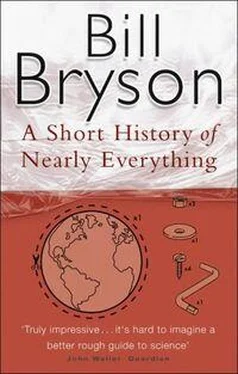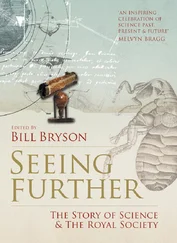Planck was often unlucky in life. His beloved first wife died early, in 1909, and the younger of his two sons was killed in the First World War. He also had twin daughters whom he adored. One died giving birth. The surviving twin went to look after the baby and fell in love with her sister’s husband. They married and two years later she died in childbirth. In 1944, when Planck was eighty-five, an Allied bomb fell on his house and he lost everything-papers, diaries, a lifetime of accumulations. The following year his surviving son was caught in a conspiracy to assassinate Hitler and executed.
Einstein was honored, somewhat vaguely, “for services to theoretical physics.” He had to wait sixteen years, till 1921, to receive the award-quite a long time, all things considered, but nothing at all compared with Frederick Reines, who detected the neutrino in 1957 but wasn’t honored with a Nobel until 1995, thirty-eight years later, or the German Ernst Ruska, who invented the electron microscope in 1932 and received his Nobel Prize in 1986, more than half a century after the fact. Since Nobel Prizes are never awarded posthumously, longevity can be as important a factor as ingenuity for prizewinners.
How c came to be the symbol for the speed of light is something of a mystery, but David Bodanis suggests it probably came from the Latin celeritas, meaning swiftness. The relevant volume of the Oxford English Dictionary, compiled a decade before Einstein’s theory, recognizes c as a symbol for many things, from carbon to cricket, but makes no mention of it as a symbol for light or swiftness.
Named for Johann Christian Doppler, an Austrian physicist, who first noticed the effect in 1842. Briefly, what happens is that as a moving object approaches a stationary one its sound waves become bunched up as they cram up against whatever device is receiving them (your ears, say), just as you would expect of anything that is being pushed from behind toward an immobile object. This bunching is perceived by the listener as a kind of pinched and elevated sound (the yee). As the sound source passes, the sound waves spread out and lengthen, causing the pitch to drop abruptly (the yummm).
The name comes from the same Cavendishes who produced Henry. This one was William Cavendish, seventh Duke of Devonshire, who was a gifted mathematician and steel baron in Victorian England. In 1870, he gave the university £6,300 to build an experimental lab.
Geiger would also later become a loyal Nazi, unhesitatingly betraying Jewish colleagues, including many who had helped him.
There is a little uncertainty about the use of the word uncertainty in regard to Heisenberg’s principle. Michael Frayn, in an afterword to his play Copenhagen, notes that several words in German-Unsicherheit, Unschärfe, Unbestimmtheit- have been used by various translators, but that none quite equates to the English uncertainty. Frayn suggests that indeterminacy would be a better word for the principle and indeterminability would be better still.
Or at least that is how it is nearly always rendered. The actual quote was: “It seems hard to sneak a look at God’s cards. But that He plays dice and uses ‘telepathic’ methods . . . is something that I cannot believe for a single moment.”
If you have ever wondered how the atoms determine which 50 percent will die and which 50 percent will survive for the next session, the answer is that the half-life is really just a statistical convenience-a kind of actuarial table for elemental things. Imagine you had a sample of material with a half-life of 30 seconds. It isn’t that every atom in the sample will exist for exactly 30 seconds or 60 seconds or 90 seconds or some other tidily ordained period. Each atom will in fact survive for an entirely random length of time that has nothing to do with multiples of 30; it might last until two seconds from now or it might oscillate away for years or decades or centuries to come. No one can say. But what we can say is that for the sample as a whole the rate of disappearance will be such that half the atoms will disappear every 30 seconds. It’s an average rate, in other words, and you can apply it to any large sampling. Someone once worked out, for instance, that dimes have a half-life of about 30 years.
There are practical side effects to all this costly effort. The World Wide Web is a CERN offshoot. It was invented by a CERN scientist, Tim Berners-Lee, in 1989.
You are of course entitled to wonder what is meant exactly by “a constant of 50” or “a constant of 100.” The answer lies in astronomical units of measure. Except conversationally, astronomers don’t use light-years. They use a distance called the parsec (a contraction of parallax and second), based on a universal measure called the stellar parallax and equivalent to 3.26 light-years. Really big measures, like the size of a universe, are measured in megaparsecs: a million parsecs. The constant is expressed in terms of kilometers per second per megaparsec. Thus when astronomers refer to a Hubble constant of 50, what they really mean is “50 kilometers per second per megaparsec.” For most of us that is of course an utterly meaningless measure, but then with astronomical measures most distances are so huge as to be utterly meaningless.
It is KT rather than CT because C had already been appropriated for Cambrian. Depending on which source you credit, the K comes either from the Greek kreta or German Kreide. Both conveniently mean “chalk,” which is also what Cretaceous means.
For those who crave a more detailed picture of the Earth’s interior, here are the dimensions of the various layers, using average figures: From 0 to 40 km (25 mi) is the crust. From 40 to 400 km (25 to 250 mi) is the upper mantle. From 400 to 650 km (250 to 400 mi) is a transition zone between the upper and lower mantle. From 650 to 2,700 km (400 to 1,700 mi) is the lower mantle. From 2,700 to 2,890 km (1,700 to 1,900 mi) is the “D” layer. From 2,890 to 5,150 km (1,900 to 3,200 mi) is the outer core, and from 5,150 to 6,378 km (3,200 to 3,967 mi) is the inner core.
The discovery of extremophiles in the boiling mudpots of Yellowstone and similar organisms found elsewhere made scientists realize that actually life of a type could range much farther than that-even, perhaps, beneath the icy skin of Pluto. What we are talking about here are the conditions that would produce reasonably complex surface creatures.
Of the remaining four, three are nitrogen and the remaining atom is divided among all the other elements.
Oxygen itself is not combustible; it merely facilitates the combustion of other things. This is just as well, for if oxygen were combustible, each time you lit a match all the air around you would burst into flame. Hydrogen gas, on the other hand, is extremely combustible, as the dirigible Hindenburg demonstrated on May 6, 1937, in Lakehurst, New Jersey, when its hydrogen fuel burst explosively into flame, killing thirty-six people.
If you have ever been struck by how beautifully crisp and well defined the edges of cumulus clouds tend to be, while other clouds are more blurry, the explanation is that in a cumulus cloud there is a pronounced boundary between the moist interior of the cloud and the dry air beyond it. Any water molecule that strays beyond the edge of the cloud is immediately zapped by the dry air beyond, allowing the cloud to keep its fine edge. Much higher cirrus clouds are composed of ice, and the zone between the edge of the cloud and the air beyond is not so clearly delineated, which is why they tend to be blurry at the edges.
Читать дальше












